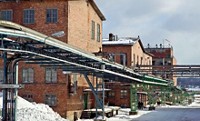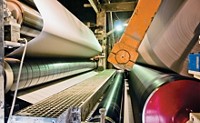Advertisement
Grab your lab coat. Let's get started
Welcome!
Welcome!
Create an account below to get 6 C&EN articles per month, receive newsletters and more - all free.
It seems this is your first time logging in online. Please enter the following information to continue.
As an ACS member you automatically get access to this site. All we need is few more details to create your reading experience.
Not you? Sign in with a different account.
Not you? Sign in with a different account.
ERROR 1
ERROR 1
ERROR 2
ERROR 2
ERROR 2
ERROR 2
ERROR 2
Password and Confirm password must match.
If you have an ACS member number, please enter it here so we can link this account to your membership. (optional)
ERROR 2
ACS values your privacy. By submitting your information, you are gaining access to C&EN and subscribing to our weekly newsletter. We use the information you provide to make your reading experience better, and we will never sell your data to third party members.
Environment
The Paper Chase
With the help of specialty chemicals, papermakers seek endless recycling of scarce fibers
by Melody Voith
April 19, 2010
| A version of this story appeared in
Volume 88, Issue 16

The decline of print newspapers and magazines is a source of concern for journalists, but it also has an impact on the worldwide paper market. After coming to depend on readers to dutifully recycle their old periodicals, paper manufacturers are now finding that supplies of high-quality paper for recycling are becoming scarce.
Used white office paper is also getting increasingly hard to find—and much more costly—thanks to growth in electronic communications. High-quality white paper is desired as a raw material for new paper. It contains long cellulose fibers with intact cell walls that can be used to make high-margin products for printing, packaging, or household use.
Seventh Generation, a marketer of green consumer products, is experiencing this paper chase firsthand. The Vermont-based company contracts with an outside paper mill to manufacture a line of 100% recycled paper products that appeals to eco-conscious consumers. "Our paper mill has had to extend beyond its initial geographical reach for recycled papers," says Martin Wolf, director of product and environmental technology at the company.
Although Seventh Generation's customers demand products that are environmentally friendly, they also want them to be pleasant to use, particularly when it comes to toilet paper. "We want a recycled paper that has certain quality," Wolf says. "We look for the longest fiber possible for strength and absorbency, and as flexible a fiber as possible so toilet tissue is soft." For most products, Seventh Generation uses 80% postconsumer paper, much of which is white office paper collected from municipalities.
Of course, the paper industry's gold standard raw material—and its most expensive one—is virgin pulp from newly harvested trees. These fibers start out long and strong, but they get shorter and weaker each time they are recycled. Recycled paper made from lower quality brown paper and paperboard has the shortest, weakest fibers.
Today, about half of all paper produced worldwide is later recycled, and papermakers will continue to increase the amount of recycled content in all types of paper, industry watchers say. Chemical companies that supply papermakers with bleaching and processing aids are introducing new products to make those fibers go further. The best of them also reduce costs by helping paper mills recycle water and save energy.
The pulp and paper industry is one of the largest consumers of chemicals in North America, according to the market research firm Frost & Sullivan. Every ton of paper and paperboard produced requires 600 lb of basic and specialty chemicals. Most paper chemicals firms offer a wide range of products, from commodities such as hydrogen peroxide to process chemicals including enzymes, biocides, and defoamers to functional aids such as sizing chemicals, coatings, and binders.
To keep costs down, papermakers are using lower and lower grades of recycled fiber and attempting to make higher grades of paper with it. The trend has created a growing niche for functional chemicals that improve aspects of paper quality including strength, water repellency or absorbency, softness, smoothness, color and brightness, and printability.
While they work to introduce technical advances, chemical firms that serve the paper industry are adjusting to two disruptive market trends. One is a consolidation among paper companies. The increased market concentration means chemical firms "struggle to operate in an already mature market with a reduced customer base," Frost & Sullivan analyst Easwaran S. Anandaraman says. The fewer, larger paper firms have increased bargaining power when it comes to buying chemicals, he adds.

To stay profitable, paper chemicals providers themselves have been furiously consolidating over the past few years. Kentucky-based Ashland expanded its paper chemicals offerings when it bought Hercules in 2008. Finland's Kemira embarked on multiple acquisitions in the 2000s, including taking over the paper chemicals business of Lanxess in 2006. BASF, based in Germany, vaulted to the lead spot in paper chemicals on the strength of its 2006 purchase of Engelhard and last year's takeover of Ciba.
The other market disruption has been the stagnation of the pulp and paper industry in Europe and North America, a long-term trend that worsened in the economic downturn. Paper manufacturing is moving rapidly to Asia, particularly China, where demand for newspaper, packaging, and household tissues and towels is growing fast.
Recently, the decline in paper output in the U.S. has been steep. Executives differentiate between three main types of paper: premium writing, including newspaper and magazine paper; packaging; and tissue and towel. Mike O'Byrne, director of the packaging segment at Ashland Hercules Water Technologies, estimates that the recession took a 15% bite out of overall paper demand. Packaging and tissue markets have recovered somewhat, but premium writing "took a hit from electronic media and the decline of ad-revenue-dependent newspapers and magazines," O'Byrne says. "Those have not recovered."
O'Byrne stresses that Ashland has been working to shift its business focus toward the East. "Demand for paper over there is good news for us," he says. "Growth in emerging markets is one of our top priorities." It hasn't been easy, he admits. "We're a North America-centric company, so it represents certain challenges. We're evolving along with the paper business." Ashland currently gets 12% of its paper chemicals revenues from Asia, compared with 46% from North America.
Until a few years ago, papermaking in China revolved around constructing cardboard boxes for exported goods. But now, O'Byrne says, "China is installing world-class paper machines. Early in the recession, a lot of announced operations were postponed, but they seem to have recovered over there within the last six months. They've been making up for the demand drop-off in mature economies, no question about that."
The market for paper chemicals in China is only about $1.1 billion annually today, Anandaraman says, but it is growing at a rate of 10–12% per year. In contrast, growth is minimal in the developed economies; the $7.5 billion North American market and the $6 billion European market are expanding by just 1–3% per year.
Chinese papermakers, like their counterparts in the developed world, look to chemical suppliers to help them keep costs down. But China suffers from a dearth of homegrown paper pulp, and its industry's biggest difficulties come from its reliance on imported waste paper for a large part of its paper needs.
"Looking at the size of China and its population, the amount of available fiber per capita is astonishingly low," says Scott Rosencrance, senior manager of R&D at Kemira. To make paper, China must import an enormous amount of used paper, mostly from North America and Europe. In 2009, according to the market research firm RISI, China imported roughly 27 million tons of paper for recycling.
China's paper industry does import some virgin pulp, but it is not generally derived from the long-fibered fir and pine trees typically harvested in North America and Europe. Instead, its new pulp is made from the shorter fibers of fast-growing South American eucalyptus trees. Overall, Rosencrance says, "the diverse set of fiber sources present in China leads to a diverse set of chemical supply needs."
Frost & Sullivan's Anandaraman agrees, and notes that the need for specialty chemicals for paper is on the rise worldwide. By his analysis, the chemicals most in demand are wet-strength and dry-strength additives, coatings, drainage and retention aids, and deinking agents. In addition to improving the quality of papers made with recycled fibers, many specialty chemicals do double or triple duty as water or energy savers.
At Ashland Hercules Water Technologies, the focus is on two major areas: increasing the strength of paper made from recycled fibers and dealing with the complex water contamination issues that arise from washing and preparing old paper for reuse. O'Byrne says the highest growth paper markets for the company are packaging grades and tissue and towel grades.
Paper is made by pouring a slurry of water and 1% pulp onto a platform constructed of wire mesh. The water slips through, leaving a damp film of pulp that is dried into paper. Higher-end papers are then coated to create a smooth, glossy surface. Publishers and packaging makers prefer coated papers because they show off high-quality printing and graphics.
To improve paper strength, Hercules developed a product line that was recently introduced by Ashland. Named Hercobond 6000, the series of performance chemicals is based on modified polyamines that form both hydrogen and ionic bonds with paper fibers and the smaller particles of cellulose called fines. The bonds help to keep the shorter fibers from pulling apart.
Adding Hercobond, Ashland claims, creates a stronger end product and allows papermakers to run their machines at higher speed. Moreover, the company says, the additive reduces the amount of fiber and solids that enter the wastewater and allows the paper to dry faster, saving on energy costs.
Ashland is also helping its paper customers close their water loop. Pulp made of recycled fibers presents particular water-treatment challenges. "It's got contaminants—bacteria, waxes, and adhesives. It's a challenge to keep the papermaking process clean," O'Byrne points out.
To kill off microbes that like to feast on cellulose in the pulp-water slurry, paper companies often use strong oxidizing biocides, such as bleach, chlorine dioxide, and hypobromous acid. Ashland says its Spectrum ammonium bromide biocide effectively controls microorganisms in alkaline systems without the need for strong oxidizers. The additive is manufactured on-site, and after doing its job, the firm claims, it quickly degrades into inert compounds.
The company also offers a more gentle way to remove all the sticky stuff that can come with recycled paper. Ashland's Presstige biosolvent was designed to remove the stickies that land on the wire mesh and clog its pores. The firm says the biosolvent, which is made from oils derived from crops and is biodegradable, has a much better safety, health, and environmental profile than commonly used industrial solvents such as hexane, toluene, and D-limonene.
Preventing the gummy goo from landing on paper equipment to begin with calls for an additive known as a detackifier. Ashland sells a natural polymer-based product called DeTac that adsorbs onto the sticky bits that are suspended in the pulp solution and makes their surface less adhesive. Assaulted by fewer sticky particles, paper machines run more quickly and produce paper with fewer holes. Ashland boasts that both of its biobased products emit fewer volatile organic compounds compared with competing products.
Such environmentally friendly chemicals will grow in popularity in the paper industry, Frost & Sullivan's Anandaraman says, especially if they also help to cut costs. "This creates a huge opportunity for pulp and paper chemicals manufacturers to engage in research and development activities to bring out greener products," he suggests.
Kemira develops new technologies for recycled fibers at its technology center in Atlanta. The company has chosen a strategy built around tissue paper manufacturing in emerging economies. "Globally, it's a growing market," Rosencrance says. "It makes sense: As Third World countries industrialize, the need for personal-care paper products dramatically increases. What was a luxury becomes a societal norm."
One tricky step standing between old paper and new tissue is taking out the ink. Conventional deinking processes employ soap and surfactant technology, but using a high percentage of recycled paper can yield tissue that is gray or spotty. Kemira developed what it calls a modified inorganic particle. It consists of a particle such as calcium carbonate that's been surface-treated with surfactants and polymers to improve the efficiency of ink removal from wastepaper during processing.
Kemira also has developed a new technology to improve retention—the paper system's ability to make the wet sheet hold on to small fibers, fine particles, and fillers instead of letting them pass into the wastewater. To do this, chemical additives use the processes of coagulation and flocculation to increase the size of small particles. The trick to Kemira's Kemform technology is the addition of hydrophobically incorporated micropolymers to standard silica or bentonite drainage enhancers.
AkzoNobel's paper business, known as Eka Chemicals, specializes in retention additives. Its system of four Compozil Fx products allows papermakers to customize their retention formulas based on the type of paper and speed of operation. The retention aids are made from anionic colloidal silicas, polyacrylamides, and other polymers.
Advertisement
Using fillers is another way to stretch recycled paper because they can take the place of some of the fiber. Most fillers are basic chemicals such as calcium carbonate, calcium sulfate, kaolin, and silicates. But BASF has introduced a polymeric filler called Luredur specifically designed for paperboard used in packaging, where dry strength is a must. Adding the polymer increases the compression and tensile strength of a package, BASF says, while reducing fiber consumption and weight.
Once paper has been formed and dried at the mill, some of it will move on to a coating operation, where the manufacturer puts a smooth white finish on the rough paper for high-quality printing or photographic applications. The coating may include finely ground calcium carbonate, fine kaolin clay, starch, acrylic latex, dispersants, and lubricants.
David Lewis, a BASF technical specialist in paper coatings, describes the process as a battle between speed and effectiveness. "You have a high-solids coating being applied to a moving web of paper in a very small gap between a rigid blade and the sheet itself," he says. "At this point, excess coating is metered off, leaving a nice, even, thin film. But when manufacturers crank up the speed, the already high shear forces in this gap increase substantially, which creates problems because the binders and pigments don't flow very well." Adding water makes the mixture flow better, but then more energy is later required to dry the coating.
To improve the rheology, or flow, of the coating, BASF offers a water-holding additive called Serocoll FS that allows papermakers to use coatings with a higher proportion of solids for a better quality printable surface. "A huge side benefit is it requires far less energy to dry and less water is needed," Lewis points out.

Chemical firms such as BASF that specialize in dressing up recycled fibers into new, high-quality papers will continue to see strong demand for their products, Anandaraman predicts. RISI forecasts a continued rise in recycled-paper usage as the economy rebounds through 2011. To meet the demand, collectors will have to dig further into the waste stream.
That's bad news for Seventh Generation. Already, Wolf points out, the office paper the company relies on contains increasing amounts of recycled paper, making it less useful for high-quality personal paper products. "The biggest challenge, especially for our toilet paper products, is perceived softness. The North American consumer is quite accustomed to pretty soft paper," Wolf laments, "but there is only a certain amount of softness you can achieve with recycled fibers." He sees an opportunity for new, sustainable paper chemistry.
O'Byrne is sympathetic, acknowledging that "the challenge comes in the fiber." Although Ashland can't make fibers longer, he points to research on modifying them with enzymes. And there are plenty of other ideas in the pipeline, he adds.
"We're talking about making recycled fibers bond better with synthetic resins and adding new coatings and barrier additives to help compensate for lack of strength or performance," O'Byrne promises. Yes, good used paper is in short supply, but North Americans just might get soft, recycled toilet paper after all.





Join the conversation
Contact the reporter
Submit a Letter to the Editor for publication
Engage with us on Twitter